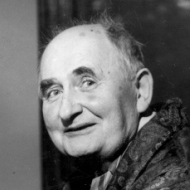ALOIS HABA was a composer, music theoretician, teacher and organiser, one of the creators of new tonal systems on the basis of intervals of less than a half-tone (quarter-tone, fifth-tone and sixth-tone). Haba introduced these microtonal systems into his music both practically and theoretically, tying up independently with the first tentative compositional and theoretical quarter-tone attempts of Stein, Moellendorf and Mager. Haba is so far the only composer to have written microtonal compositions on a melodic-harmonic base, in all forms of modern music and for the most varied instrumental and vocal content. For this he used on the one hand traditional instruments, but he also proposed new instruments - quarter-tone pianos, the quarter-tone harmonium, quarter-tone clarinets, quarter- tone trumpets, and the sixth-tone harmonium, which were manufactured by Czech and German firms of instrument makers. Haba's microtonal systems are based on the complete utilization of all tones in the microtonal series. Haba does not see these microtones of his as new interval values but as alterations in scale and non-scale intervals of the half-tone system by which he wishes only to emphasize the content aspect of his music. From the theoretical point of view Haba carried out the mechanical division of the octave into equal micro-intervals. Haba anchors this musicality inspirationally and musically in his striking native region of Moravian Wallachia, in the songs of which archaic manners of interpretation including singing in micro-intervals have been retained. Haba also composed in the half-tone system. During his time with the Universal Edition publishers (1918-1920) he became a fan of Schoenberg's harmonic radicalism with its "semitone" chords and aggressive intervals of small seconds, large sevenths and small ninths. Basically however, he rejected Schoenberg's free and organised "atonality" (with "twelve only mutually relating tones") which he replaced with the principle of tonal centrality (the relation of the tones and chords to the tone or chord center). In melody and rhythm Haba thinks independently of Schoenberg. He does not take so much pleasure in abrupt (unmelodic) intervals, the melody of his compositions is fluent and lyrical. Haba began both his amateur and professional careers as a musician and an instrumentalist. He played the violin and the double bass in his father's folk orchestra and in the pupils' orchestra of the teaching institute in Kromeriz (1908 -1912). Even before entering the master's class in composition of V. Novak (1914), he took the State examination in the violin and thus gained his first professional qualification. These first professions of Haba's help to explain his life-long love of instrumental music. The instrument does not perhaps exist for which he did not write a composition or at least use it in a chamber ensemble. Instrumental chamber music also forms a landmark in Haba's creativity. Haba came from a region which is known for its melodic and expressive speech. The characteristic alternation of short and long syllables in words, the melodious vaulting of sentences and phrases became in the case of Haba, as earlier in the case of Janacek, an inseparable and constant characteristic of his verbal expression. He had a sense for the beauty and lyricism of his native language as a composer also. Haba's first great vocal work, the opera "Mother", opus 35 (1929), immediately presents him as an eager and independent follower of Janacek. Haba's airs and songs grow organically from the melodious flow of speech, which he was also able to transpose stylistically into music. After the time of his studies under V. Novak (1914 -15) and later under F. Schreker (1918 - 22) Haba educated himself musically on his own. His theoretical interest in everything new had a deeper sense. He never ceased to ask himself questions about the sense of musical creativity, the real existence of which is created by the structural tonal components. He was musician and thinker in one person. At the time of the struggles for a socially and nationally just society this thinking of Haba's was enriched by traits which ranked him among the leading artistic supporters of socialist ideas in musical creativity and in musical life as a whole. As early as the twenties he was one of the supporters of "pure" music. The quarter-tone opera "Mother", opus 35, with its socially motivated glorification of the ordinary man and his faith in justice, is the start of a line of socially and socialistically committed works, the material of which reflects the struggle of the democratic forces against fascism and the regressive aspects of the supreme capitalist society. For Haba the composer and the theorist it was typical not to link this humanistic mission of his work with ephemeral concessions which would have weakened the clarity and penetration of the style and language of his music. He saw the newness of music and ideas in unity as an divisible aesthetic axiom and as the prerequisite for the lasting cultural and social effect of his work. From 1923 onwards Haba lived permanently in Prague. Through his compositions, his work as a teacher at the State Music Conservatory and the Academy of Arts and Music in Prague (up to 1950), his organizational activity in music societies (the Society for Modern Music, Pritomnost (The Present), the Syndicate of Czech Composers, the Union of Czechoslovak Composers) and his work as a director in the Great Opera of 5th May (today The State Opera) he had a penetrating effect on contemporary musical life.

